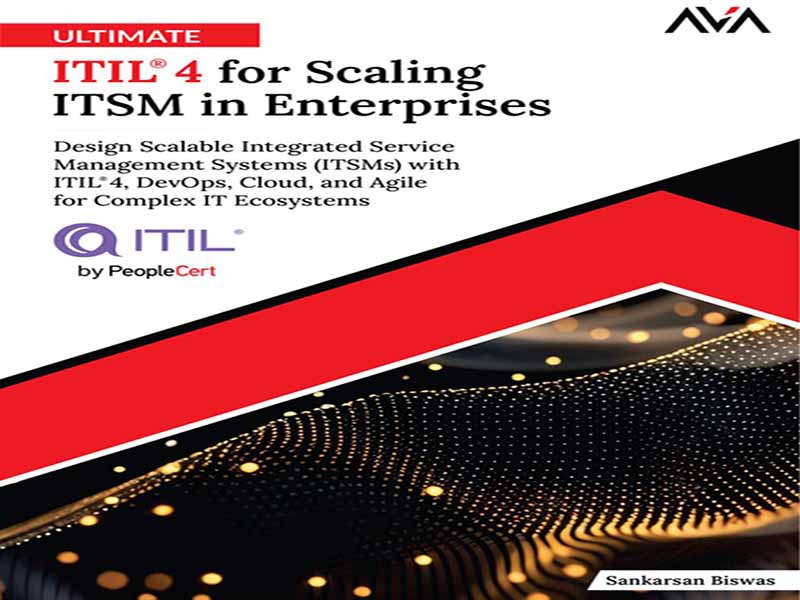- عنوان کتاب: Ultimate ITIL® 4 for Scaling ITSM in Enterprises Design Scalable Integrated Service Management Systems (ITSMs) with ITIL ® 4, DevOps, Cloud, and Agile for Complex IT Ecosystems
- نویسنده: Sankarsan Biswas
- حوزه: ITIL V4
- سال انتشار: 2025
- تعداد صفحه: 575
- زبان اصلی: انگلیسی
- نوع فایل: pdf
- حجم فایل: 8.56 مگابایت
حوزه مدیریت خدمات فناوری اطلاعات (ITSM) با سرعتی بیسابقه در حال تکامل است. سازمانها امروزه نه تنها با چالش اتخاذ بهترین شیوهها، بلکه با چالش مقیاسبندی مؤثر آنها در محیطهای پیچیده و پویا نیز روبرو هستند. با درک این موضوع بود که کتاب Ultimate ITIL ® 4 برای مقیاسبندی ITSM در سازمانها تدوین شد. پس از موفقیت اولین کتابم، راهنمای صدور گواهینامه بنیاد Ultimate ITIL ® 4، و با الهام از استقبال چشمگیر متخصصان در صنایع مختلف، احساس کردم که باید فراتر از اصول اولیه بروم. بسیاری از خوانندگان و متخصصان به دنبال راهنمایی عمیقتر – نه فقط در مورد چیستی ITIL4، بلکه در مورد نحوه اعمال و مقیاسبندی عملی آن در سناریوهای سازمانی دنیای واقعی – بودند. این کتاب برای کسانی نوشته شده است که از قبل اصول و شیوههای ITIL4 را درک میکنند، اما اکنون به دنبال ارتقاء شیوههای ITSM خود برای برآورده کردن خواستههای سطح سازمانی هستند. این کتاب یک راهنمای جامع برای مفاهیم پیشرفته، مطالعات موردی دنیای واقعی، استراتژیهای مقیاسبندی اثباتشده، فرصتهای اتوماسیون و سفارشیسازیهای خاص صنعت ارائه میدهد – که همگی با هدف کمک به سازمانها برای ایجاد ارزش قابل اندازهگیری از طریق ITSM است. هدف این اثر، پر کردن شکاف بین تئوری و اجرا است و به رهبران، متخصصان و استراتژیستهای ITSM کمک میکند تا نه تنها ITIL4 را به طور مؤثر پیادهسازی کنند، بلکه در دنیایی که اولویت با دیجیتال است، خود را با آن وفق داده و رشد کنند. صمیمانه امید است که این کتاب به همراهی قابل اعتماد در مسیر شما به سوی ساخت اکوسیستمهای ITSM مقیاسپذیر، انعطافپذیر و در حال بهبود مداوم تبدیل شود. این کتاب در ۱۳ فصل سازماندهی شده است که مبانی پیادهسازی پیشرفته ITIL4، بررسی عمیق شیوههای ITIL4، استراتژیهای ادغام و مقیاسبندی، روشهای اندازهگیری و حفظ موفقیت، روندها و نوآوریهای نوظهور در ITSM و راهنمایی در مورد سفر آینده برای متخصصان ITIL4 را پوشش میدهد. فصل ۱ مقدمهای استراتژیک بر مفاهیم پیشرفته ITIL4 ارائه میدهد و دانش بنیادی را از استراتژیهای پیادهسازی در سطح سازمانی متمایز میکند. این فصل بررسی میکند که چگونه ITIL4، ITSM مدرن را، به ویژه در محیطهای پویا که توسط محاسبات ابری، هوش مصنوعی، DevOps و روشهای چابک شکل گرفتهاند، توانمند میسازد. فصل ۲ به بررسی مجدد اجزای اصلی ITIL4 – سیستم ارزش خدمات (SVS)، زنجیره ارزش خدمات و چهار بُعد مدیریت خدمات – میپردازد و به جای درک نظری، بر کاربرد عملی آنها در ابتکارات استراتژیک ITSM تمرکز میکند. فصل ۳ در مورد چگونگی پر کردن شکاف بین استراتژی کسبوکار و اجرای فناوری اطلاعات توسط ITIL4 بحث میکند. این فصل اصول کلیدی را برجسته میکند که شرکتها را قادر میسازد تا قابلیتهای ITSM خود را مدرن کنند و چابکی، انعطافپذیری و کارایی عملیاتی را در دنیایی که دیجیتال حرف اول را میزند، تضمین کنند. فصل ۴ به بررسی ادغام حاکمیت، ریسک و انطباق (GRC)، مدیریت تغییر سازمانی (OCM) و مدیریت دانش در رویههای ITIL4 میپردازد. این فصل تأکید میکند که چگونه گنجاندن حاکمیت و بهبود مستمر در فرهنگ سازمانی برای دستیابی به بلوغ پایدار ITSM حیاتی است. فصل ۵ بررسی عمیقی از رویههای کلیدی مدیریت خدمات ITIL4، از جمله مدیریت حوادث، مدیریت مشکلات، فعالسازی تغییر، مدیریت درخواست خدمات و مدیریت سطح خدمات، ارائه میدهد. این فصل به بررسی گردشهای کاری پیشرفته، استراتژیهای اتوماسیون و بهترین شیوهها برای افزایش کارایی ITSM در مقیاس بزرگ میپردازد. فصل 6، شیوههای ضروری مدیریت فنی ITIL4 مانند مدیریت زیرساخت و پلتفرم، مدیریت استقرار، و نظارت و مدیریت رویداد را پوشش میدهد. همچنین توضیح میدهد که چگونه میتوان این شیوهها را با روشهای DevOps و Agile ادغام کرد تا تحویل مداوم، استقرار خودکار و مدیریت خدمات پیشگیرانه امکانپذیر شود. فصل 7 بر ترکیب ITIL4 با اصول Agile، DevOps و Lean تمرکز دارد تا اطمینان حاصل شود که ITSM سنتی به جای جلوگیری از نوآوری، پشتیبانی را کنترل میکند. این فصل، بهترین شیوهها را برای تطبیق گردشهای کاری ITIL4 با مدلهای توسعه تکراری، ایجاد تعادل بین ثبات، انطباق و چابکی برجسته میکند. فصل 8، استراتژیهایی را برای مقیاسبندی ITIL4 در شرکتهای پیچیده و جهانی تشریح میکند. این فصل بر مدلهای حاکمیتی، اتوماسیون، استانداردسازی فرآیند و همکاری بینبخشی برای اطمینان از مدیریت یکپارچه خدمات در مناطق جغرافیایی و واحدهای تجاری تأکید دارد. فصل 9، چگونگی سنجش عملکرد ITIL4 توسط شرکتها را با استفاده از شاخصهای کلیدی عملکرد (KPI)، توافقنامههای سطح خدمات (SLA) و نقشهبرداری جریان ارزش مورد بحث قرار میدهد. این فصل بر همسوسازی ابتکارات ITSM با نتایج تجاری، رضایت مشتری و تعالی عملیاتی تمرکز دارد. فصل ۱۰ رویکردی دقیق برای ایجاد ساختارهای حاکمیتی مبتنی بر ITIL4 و گنجاندن بهبود مستمر در عملیات روزانه ارائه میدهد. این فصل یک راهنمای گام به گام برای بهرهگیری از بینش دادهها، اتوماسیون و حلقههای بازخورد برای دستیابی به تعالی پایدار در خدمات ارائه میدهد. فصل ۱۱ به بررسی روندهای پیشرفته مانند ITSM مبتنی بر هوش مصنوعی، تجزیه و تحلیل پیشبینیکننده، سیستمهای خوددرمانی و تحول خدمات دیجیتال میپردازد. این فصل بررسی میکند که چگونه فناوریهای نوظهور، پذیرش ITIL4 را تغییر شکل میدهند و کارایی عملیاتی را افزایش میدهند.
The field of IT Service Management (ITSM) is evolving at an unprecedented pace. Organizations today face the challenge of not just adopting best practices, but scaling them effectively across complex, dynamic environments. It was with this realization that Ultimate ITIL ® 4 for Scaling ITSM in Enterprises was conceived. Following the success of my first book, Ultimate ITIL ® 4 Foundation Certification Guide , and inspired by the overwhelming response from professionals across industries, I felt the need to go beyond the basics. Many readers and practitioners reached out seeking deeper guidance — not just on what ITIL4 is, but how to apply and scale it pragmatically in real-world enterprise scenarios. This book is written for those who already understand ITIL4 principles and practices but are now seeking to elevate their ITSM practices to meet enterprise-level demands. It provides a comprehensive guide to advanced concepts, real-world case studies, proven scaling strategies, automation opportunities, and industry-specific customizations — all aimed at helping organizations drive measurable value through ITSM. The intent of this work is to bridge the gap between theory and execution, helping ITSM leaders, practitioners, and strategists to not only implement ITIL4 effectively but also to adapt and thrive in a digital-first world. It is sincerely hoped that this book becomes a trusted companion for your journey towards building scalable, resilient, and continually improving ITSM ecosystems. This book is organized into 13 chapters, covering the foundations of advanced ITIL4 implementation, an in-depth exploration of ITIL4 practices, strategies for integration and scaling, methods for measuring and sustaining success, emerging trends and innovations in ITSM, and guidance on the future journey for ITIL4 professionals. Chapter 1 offers a strategic introduction to advanced ITIL4 concepts, differentiating foundational knowledge from enterprise-level implementation strategies. It explores how ITIL4 empowers modern ITSM, particularly in dynamic environments shaped by cloud computing, AI, DevOps, and Agile methodologies. Chapter 2 revisits ITIL4’s core components—the Service Value System (SVS), Service Value Chain, and the Four Dimensions of Service Management—focusing on their practical application in strategic ITSM initiatives rather than theoretical understanding. Chapter 3 discusses how ITIL4 bridges the gap between business strategy and IT execution. It highlights key principles that enable enterprises to modernize their ITSM capabilities, ensuring agility, resilience, and operational efficiency in a digital-first world. Chapter 4 explores the integration of Governance, Risk, and Compliance (GRC), Organizational Change Management (OCM), and Knowledge Management into ITIL4 practices. It emphasizes how embedding governance and continual improvement into organizational culture is critical for achieving sustainable ITSM maturity. Chapter 5 provides an in-depth exploration of key ITIL4 service management practices, including Incident Management, Problem Management, Change Enablement, Service Request Management, and Service Level Management. It delves into advanced workflows, automation strategies, and best practices to enhance ITSM efficiency at scale. Chapter 6 covers essential ITIL4 technical management practices such as Infrastructure and Platform Management, Deployment Management, and Monitoring and Event Management. It also explains how to integrate these practices with DevOps and Agile methodologies to enable continuous delivery, automated deployment, and proactive service management. Chapter 7 focuses on blending ITIL4 with Agile, DevOps, and Lean principles to ensure that traditional ITSM controls support rather than hinder innovation. It highlights best practices for adapting ITIL4 workflows to iterative development models, balancing stability, compliance, and agility. Chapter 8 outlines strategies for scaling ITIL4 across complex, global enterprises. It emphasizes governance models, automation, process standardization, and crossfunctional collaboration to ensure seamless service management across geographies and business units. Chapter 9 discusses how enterprises can measure ITIL4 performance using Key Performance Indicators (KPIs), Service Level Agreements (SLAs), and Value Stream Mapping. It focuses on aligning ITSM initiatives with business outcomes, customer satisfaction, and operational excellence. Chapter 10 provides a detailed approach to building ITIL4- based governance structures and embedding continual improvement into daily operations. It offers a step-by-step guide for leveraging data insights, automation, and feedback loops to drive lasting service excellence. Chapter 11 explores cutting-edge trends such as AI-driven ITSM, predictive analytics, self-healing systems, and digital service transformation. It examines how emerging technologies are reshaping ITIL4 adoption, enhancing operational efficiency, and driving real-time optimization. Chapter 12 provides practical strategies for overcoming common challenges faced during ITIL4 implementation. It addresses managing resistance to change, optimizing workflows for agility, and aligning ITIL4 initiatives with broader digital transformation goals. Chapter 13 explores the evolving career landscape for ITIL4 practitioners. It highlights emerging roles, key skills for the future, opportunities for professional development, and guidance on aligning ITIL4 expertise with Agile, DevOps, and digital transformation leadership.
این کتاب را میتوانید از لینک زیر بصورت رایگان دانلود کنید:





































نظرات کاربران